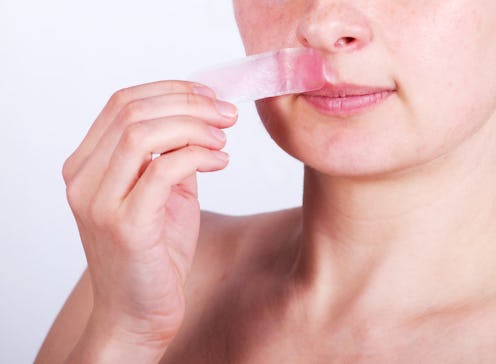Beauty
How To Wax Your Face Safely At Home, According To Experts
Do *not* follow that TikTok waxing trend.

It's pretty common to use wax to remove hair from your face. Covering your entire head in wax, as seen in a bunch of recent viral TikToks, however, is another story. If you're looking to remove some peach fuzz, Bustle got the lowdown from experts on exactly how to wax your face safely. (Spoiler alert: It looks nothing like it does in the aforementioned TikTok videos.)
"You don't want to wax your whole face at once," says Dr. Shirley Chi, M.D., a Los Angeles-based board-certified dermatologist. Whatever you do, she warns, it's important to follow the instructions of whichever wax product you're using — and none of them will instruct you to apply wax to your entire face in one go because you'd be putting your skin at risk of an adverse reaction or a burn.
With home waxing, you can turn to wax strips (strips that already have wax on them), or hard or soft wax. "Wax strips are an easy at-home option and are great for on-the-go needs," says Danielle Hogues, licensed esthetician and grooming brand MyHare product consultant. "With hard wax, you peel it off when it hardens. And soft wax involves taking it off with a strip of muslin, a soft, fabric-like strip."
The appeal of waxing versus, say, plucking or laser hair removal, is that it's easy to DIY. "Facial waxing works by removing hair from pores by the root," Hogues tells Bustle. "Many people like having their faces waxed to create a smoother surface for makeup application." Because wax pulls hair from the root, your skin stays smooth for an average of four weeks (the key word being average, as not everyone will stay stubble-free for that long), says Allie Melnick, vice president of personal care brand Flamingo.
But just because it's simple to do yourself doesn't mean you shouldn't follow certain protocols — waxing can damage your skin when done incorrectly. First of all, be sure to stop using retinoids, retinol, and strong alpha hydroxy-acids for at least eight days prior to waxing, says Chi, as these can increase your skin's sensitivity. Hogues adds that consuming alcohol and being on or near your period can also make your skin more sensitive, so time your waxing sesh wisely.
You also want to make sure your hair is long enough — Melnick says it should be at least a quarter of a centimeter in length (or as thick as a quarter) so the wax has enough to hold onto. Chi also suggests avoiding the area around the eyes — specifically under the eyebrow — since it's thinner than the skin on the rest of your face and can get damaged by waxing (she recommends plucking instead). Other than that, both Hogues and Chi recommend doing a patch test on a small section of your skin before tackling the rest of your face to make sure you don't have any adverse reactions.
Here, experts share the four most important rules to follow when waxing your face at home. Pro tip? "Wax at night before you go to bed," says Melnick. "This gives your skin a few hours to recover before you face the world."
1. Prep Your Skin
Hogues says to start with a clean face. "Remove makeup and wash your face with a gentle gel or cream cleanser," she tells Bustle. "Don't put lotion or serums on afterwards. Post cleansing, you could opt for a gentle toner like witch hazel as an extra prep of the skin before you wax." A fresh face prevents debris or buildup in the pores from getting in the way of an effective wax.
2. Apply Wax — But Not Too Much
According to Chi, it's best to apply a thin layer of wax (that goes for both hard and soft wax). "If you put it on thick, it can cause a burn because, if you're using hot wax, the temperature is really high," she tells Bustle. If you miss a spot, go back over the area with your wax strips or cloths, but avoid applying more wax to the same spot (this increases your risk of irritation or a burn, she says).
3. Remove The Wax Properly
The most common mistake people make when waxing their face is applying or removing it incorrectly, says Hogues. "Make sure you always remove the wax in the opposite direction as hair growth," she says. Otherwise, pulling along with the hair can cause more pain and irritation, says Melnick. Also important? "When waxing your face, you should always hold the area you're waxing taut." Do it swiftly to make sure no wax gets left behind.
4. Apply A Cream Immediately Afterward
Whatever you do, don't touch the area you just waxed. "This can transfer bacteria," says Melnick. Then, to ensure your freshly waxed skin heals properly, Chi recommends applying either a hydrocortisone cream or aloe vera gel to the spot, both of which will soothe your face and quell inflammation.
This article was originally published on